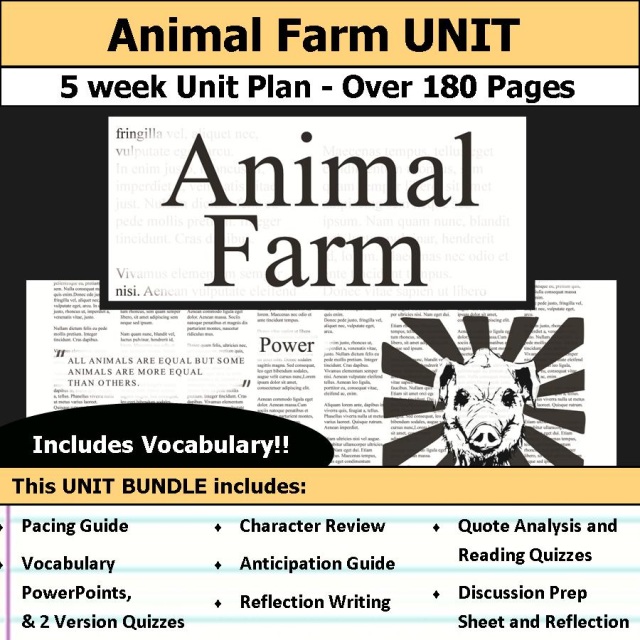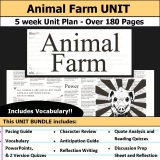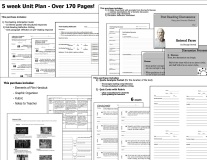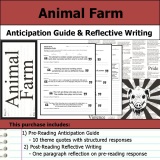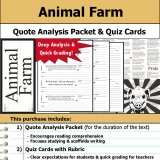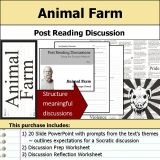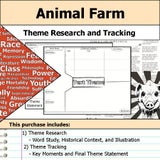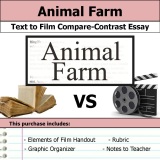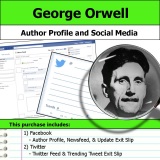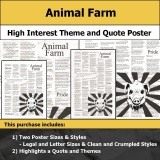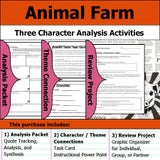- English Language Arts Unit Plans
- >
- Animal Farm Unit
Animal Farm Unit
SKU:
$18.00
$18.00
Unavailable
per item
5 weeks of lesson plans. Includes pacing guide, film essay, activities, reading quizzes, and discussions. This bundle has everything you need to get started teaching Animal Farm by George Orwell in an engaging way! This unit supports an in-depth analysis of the text. Students will be encouraged to think deeply and write about themes and character development with these activities.
animal farm unit overview
Anticipation Guide & Reflection:
Get students making "big picture" connections with this anticipation guide and reflective writing. This purchase includes a two page handout with quotes that relate to the text's theme. Students are asked to respond by indicating whether they agree or disagree with the statement and then explaining their opinion. Also included is a teacher's note to explain how to bridge this into an optional discussion, depending on how much time you have. Finally, the writing reflection asks students to relate their opinion to quotes from the text after reading.
These assignments even work well independently, in case you don't have time in your unit plan to use both.
Quote Analysis & Reading Quizzes:
A perfect tool for scaffolding deeper understanding and analysis! This is my go-to tool for helping students process key details and providing regular reading quizzes without drowning myself in grading. The scaffolded approach helps students bridge from reading for plot points to reading for deeper understanding, themes, and life lessons.
Film and Text Essay:
Elements of film handout, essay graphic organizer, rubric, and notes for the teacher. The elements of film handout defines 14 basic elements for students to use as evidence in their essays. The graphic organizer has students pre-plan which scenes their essay will focus on, structures their notes during the film, and plan their thesis statement.
Character Review Project:
Character review project has students work in groups to generate ideas for six of the main characters pertaining to a non-human topic (for example: dishes). Students draw, return to the novel for quotes, and write explanations to justify their ideas. This is a creative project that encourages abstract thinking and evidence-based writing.
Post Reading Discussion - Socratic Method:
Students feel confident with this semi-structured approach to class discussions. This purchase includes a 20 slide PowerPoint that introduces students to the Socratic method for the purpose of discussing a text, a student discussion prep sheet and reflection, and detailed instructions for the teacher on how to facilitate a class discussion. The PowerPoint also includes theme questions to help students expand their perspective on the text, or to extend a discussion that needs to delve a bit deeper.
Vocabulary Bundle:
Included in this bundle are vocabulary lists, slides, and quizzes with words coming from the text. Vocabulary words are in lists with twenty words each, PowerPoint slides with contemporary images to introduce words to students. Context clue handout also included. Vocabulary lists have lines for students to generate their own sentences using context clues.
Author Study - Profile and Social Media:
Engage students in the text using the writing platforms they are most familiar with: facebook and twitter posts. These resources support higher-level thinking skills and a literary analysis based approach to teaching. This resource includes four copy-and-go handouts: author facebook profile, facebook newsfeed, facebook exit tickets, and twitter exit tickets. There is also a note for teachers detailing multiple ways to incorporate these resources into your unit plans, including ways to use them as reading quizzes and assessments.
Theme and Quote Poster:
Highlight key themes and pique students interest with this printable poster. The image can be printed on 8.5x11 and 8.5x14 paper for a bulletin board, student workbook covers, etc. There are two styles: clean and crumpled. You can print this poster on any paper color for endless variety. You can also enlarge the image for a bigger display.
Get students making "big picture" connections with this anticipation guide and reflective writing. This purchase includes a two page handout with quotes that relate to the text's theme. Students are asked to respond by indicating whether they agree or disagree with the statement and then explaining their opinion. Also included is a teacher's note to explain how to bridge this into an optional discussion, depending on how much time you have. Finally, the writing reflection asks students to relate their opinion to quotes from the text after reading.
These assignments even work well independently, in case you don't have time in your unit plan to use both.
Quote Analysis & Reading Quizzes:
A perfect tool for scaffolding deeper understanding and analysis! This is my go-to tool for helping students process key details and providing regular reading quizzes without drowning myself in grading. The scaffolded approach helps students bridge from reading for plot points to reading for deeper understanding, themes, and life lessons.
Film and Text Essay:
Elements of film handout, essay graphic organizer, rubric, and notes for the teacher. The elements of film handout defines 14 basic elements for students to use as evidence in their essays. The graphic organizer has students pre-plan which scenes their essay will focus on, structures their notes during the film, and plan their thesis statement.
Character Review Project:
Character review project has students work in groups to generate ideas for six of the main characters pertaining to a non-human topic (for example: dishes). Students draw, return to the novel for quotes, and write explanations to justify their ideas. This is a creative project that encourages abstract thinking and evidence-based writing.
Post Reading Discussion - Socratic Method:
Students feel confident with this semi-structured approach to class discussions. This purchase includes a 20 slide PowerPoint that introduces students to the Socratic method for the purpose of discussing a text, a student discussion prep sheet and reflection, and detailed instructions for the teacher on how to facilitate a class discussion. The PowerPoint also includes theme questions to help students expand their perspective on the text, or to extend a discussion that needs to delve a bit deeper.
Vocabulary Bundle:
Included in this bundle are vocabulary lists, slides, and quizzes with words coming from the text. Vocabulary words are in lists with twenty words each, PowerPoint slides with contemporary images to introduce words to students. Context clue handout also included. Vocabulary lists have lines for students to generate their own sentences using context clues.
Author Study - Profile and Social Media:
Engage students in the text using the writing platforms they are most familiar with: facebook and twitter posts. These resources support higher-level thinking skills and a literary analysis based approach to teaching. This resource includes four copy-and-go handouts: author facebook profile, facebook newsfeed, facebook exit tickets, and twitter exit tickets. There is also a note for teachers detailing multiple ways to incorporate these resources into your unit plans, including ways to use them as reading quizzes and assessments.
Theme and Quote Poster:
Highlight key themes and pique students interest with this printable poster. The image can be printed on 8.5x11 and 8.5x14 paper for a bulletin board, student workbook covers, etc. There are two styles: clean and crumpled. You can print this poster on any paper color for endless variety. You can also enlarge the image for a bigger display.
Excellent use of quotes. I love anticipatory sets for my students before reading and this is a great one. - K. Olson
|
Helped my students organize their thoughts and saved my time. Thanks! - Lisa L.
|
ANIMAL FARM ANTICIPATION GUIDE & REFLECTION WRITING
Teacher Author's Intent: I use the anticipation guide before reading to get students thinking about the deeper issues at play in the text. It is a flexible activity that can last anywhere from 10 to 45 minutes, depending on how much time you have. With less time, I have students read each quote and respond in writing, basically just follow the instructions independently. With more time, I read each quote to the class and explain it, making sure they understand its meaning before responding. I have also had them discuss the quote with a partner or small group before responding. With even more time (such as an entire class period), I use this as the beginning of a class discussion. Give students about ten minutes to complete the anticipation guide independently. Then, after they have completed it, have them choose one statement that they would like to speak to. I encourage them to choose something they had a strong opinion about and scored either a "1" or a "5." Depending on your class and your time frame, you can have a soap box style discussion where students just explain their opinions from their seat, or you can do a discussion with desks in a circle and ask students to build off of each other's opinions.
The reflection follows the same line of thinking. I've assigned the writing individually as an assignment that may take about twenty minutes, or after a class discussion. Similar to the anticipation guide, I have students revisit those quotes either in small groups or in large groups and discuss them. This time, they need to bring in examples from the text. If you've had students take notes during the text, encourage them to use those to prepare for the discussion. Then, I found that the most thoughtful responses come when I assign students to back up their reflection writing with quotes from the text.
The reflection follows the same line of thinking. I've assigned the writing individually as an assignment that may take about twenty minutes, or after a class discussion. Similar to the anticipation guide, I have students revisit those quotes either in small groups or in large groups and discuss them. This time, they need to bring in examples from the text. If you've had students take notes during the text, encourage them to use those to prepare for the discussion. Then, I found that the most thoughtful responses come when I assign students to back up their reflection writing with quotes from the text.
ANIMAL FARM QUOTE ANALYSIS & QUIZ CARDS
Teacher Author's Intent: I love using these with any major text in my curriculum. It gives students focus for their reading homework, structures their studying, encourages deep thinking, and, not least of all, the quiz cards are a quick grade for me.
I print the Quote Analysis Packet out for each student before we start reading. After day one of reading, I review the first few quotes with the class. I want to make sure they understand what I am looking for in terms of a full credit response on the quiz. I tell students that they should expect a reading quiz the day after reading (whether it be in class or homework). They are responsible for keeping their quote analysis packet up-to-date with the amount of reading that has been assigned. (For example, if chapter one is reading homework, then it is also homework to complete the chapter one quote analysis. Or, if we read chapter one together in class, it is homework to complete the quote analysis.) Depending on how you structure your class, the quote analysis may also work well as small group or partner assignments the day after a reading.
When I give quizzes, students know beforehand that they will only be asked about one of the given quotes on the quiz. I make sure to clarify that they don't get to choose which quote they will write about on the quiz. If I have assigned multiple chapters, then the quiz will still only have one quote, and it can be from any of the assigned chapters. I also like the flexibility of this in case I have multiple hours of the same course. This way, I can use the same style of assessment and easily change the quote from hour to hour without worry of students in later hours having an unfair advantage. Ditto for students who have been absent. Also, I've found it helps to time quizzes. The perfect time limit for me is five minutes. I let students know when there is one minute left, and, at that time, I also remind them to relate their answer to something "deeper than the plot" for full credit.
My grading process for the quiz cards is my favorite part about this style of quiz. Using the rubric on the back of the quiz card, I have a pile for "10," another pile for "7," a third pile for "5," and a final pile for "1." As I read each response, I put it in the proper pile. Then, I write the score on each quiz for a given pile, stack them up, and start on the next hour. It takes me five minutes to grade on class of about 25 quizzes (The same time limit I put on the quizzes, so I can grade the previous hour's quiz in the time it takes my second hour to take the quiz. So nice!)
In terms of grade the quote analysis packets, I have a couple of things that have worked well for me. I stamp each students packet as the questions are due. Students have their packets open to the correct page at the beginning of the hour. I quickly eyeball that the quotes for the assigned reading are complete and stamp at the end of the section. (I have a handful of random stamps from craft stores for this.) At the end of the unit, students hand in their entire packet. To get full credit, each section needs to have a stamp. Then, I generally grade one quote from each section (such as the second quote in each chapter, or the second quote on each page, etc.) This stream-lines grading for me. I am transparent with my students about this from day one of reading, so they know how imperative it is to do a thorough job for a good grade.
I print the Quote Analysis Packet out for each student before we start reading. After day one of reading, I review the first few quotes with the class. I want to make sure they understand what I am looking for in terms of a full credit response on the quiz. I tell students that they should expect a reading quiz the day after reading (whether it be in class or homework). They are responsible for keeping their quote analysis packet up-to-date with the amount of reading that has been assigned. (For example, if chapter one is reading homework, then it is also homework to complete the chapter one quote analysis. Or, if we read chapter one together in class, it is homework to complete the quote analysis.) Depending on how you structure your class, the quote analysis may also work well as small group or partner assignments the day after a reading.
When I give quizzes, students know beforehand that they will only be asked about one of the given quotes on the quiz. I make sure to clarify that they don't get to choose which quote they will write about on the quiz. If I have assigned multiple chapters, then the quiz will still only have one quote, and it can be from any of the assigned chapters. I also like the flexibility of this in case I have multiple hours of the same course. This way, I can use the same style of assessment and easily change the quote from hour to hour without worry of students in later hours having an unfair advantage. Ditto for students who have been absent. Also, I've found it helps to time quizzes. The perfect time limit for me is five minutes. I let students know when there is one minute left, and, at that time, I also remind them to relate their answer to something "deeper than the plot" for full credit.
My grading process for the quiz cards is my favorite part about this style of quiz. Using the rubric on the back of the quiz card, I have a pile for "10," another pile for "7," a third pile for "5," and a final pile for "1." As I read each response, I put it in the proper pile. Then, I write the score on each quiz for a given pile, stack them up, and start on the next hour. It takes me five minutes to grade on class of about 25 quizzes (The same time limit I put on the quizzes, so I can grade the previous hour's quiz in the time it takes my second hour to take the quiz. So nice!)
In terms of grade the quote analysis packets, I have a couple of things that have worked well for me. I stamp each students packet as the questions are due. Students have their packets open to the correct page at the beginning of the hour. I quickly eyeball that the quotes for the assigned reading are complete and stamp at the end of the section. (I have a handful of random stamps from craft stores for this.) At the end of the unit, students hand in their entire packet. To get full credit, each section needs to have a stamp. Then, I generally grade one quote from each section (such as the second quote in each chapter, or the second quote on each page, etc.) This stream-lines grading for me. I am transparent with my students about this from day one of reading, so they know how imperative it is to do a thorough job for a good grade.
ANIMAL FARM SOCRATIC METHOD DISCUSSION
Teacher Author's Intent: Classroom discussions are one of my favorite ways to breathe some life into a unit. As the teacher, I use class discussions to get a handle on how much the students understand and whether they are ready for deeper analysis or if we should stick with basic plot and character level issues with the text.
To prepare a class for the first discussion of the school year, I use the PowerPoint to talk students through the process. Often, students have participated in class discussions before that were structured differently, so I want to make sure they understand what I'm looking for. I also explain how they will be graded on the discussion. I typically assign ten points each to the prep sheet, participation in the discussion, and the reflection for thirty total points possible. This works for me because students can still earn a passing grade by paying attention to the discussion even if they choose not to say anything.
After the PowerPoint, I hand out the prep sheet and give students some class time to start planning questions. For the first discussion of the year, I typically model one for the students to copy on to their worksheet so they understand how to base their questions on quotes, or the other way around (quotes to justify questions).
Class discussions typically take an entire 40 minute period. I have students split into two groups before they come to class. You know your students best: try to have an even number of "talkers" in each group. Then, I set a timer for 15-20 minutes and ask the outer circle who would like to ask a question first. You might clarify that not every student has to answer every question.
After the time is up, have the students switch places and repeat the process. It's okay if some questions are asked a second time since this is a new group. If the discussion starts to fizzle, you can use the theme questions at the end of the PowerPoint to get students talking about "big picture" concepts. With a few minutes left in class, I encourage students to get started on the reflection while the discussion is fresh in their minds. The reflection is usually homework that I collect the next day in class.
Assigning points for the discussion is something I continue to perfect. You might try making a chart with student names down one side and the traits you are looking for across the top to help you keep track of the number and quality of the responses. Things I keep track of include: original contributions, specific references to the text, literary elements, including others in the discussion, etc. (Sometimes I track off topic or disrespectful responses if that is an issue for a particular class.) I've also experimented with using a chart to "map" student responses. In this style, each student has a box with their name in it. I use tally marks to track responses and write notes in their box. I draw lines to "follow" the discussion on paper. I find this style keeps me busy, which often keeps me quieter during the discussion. :)
For students who talk too much or too little, I've tried giving "two cents" to each student. They have to "put in their two cents" each time they talk, and then listen to everyone else before they talk again. This isn't ideal, but for some classes, I've found it's necessary to limit some and encourage others.
To prepare a class for the first discussion of the school year, I use the PowerPoint to talk students through the process. Often, students have participated in class discussions before that were structured differently, so I want to make sure they understand what I'm looking for. I also explain how they will be graded on the discussion. I typically assign ten points each to the prep sheet, participation in the discussion, and the reflection for thirty total points possible. This works for me because students can still earn a passing grade by paying attention to the discussion even if they choose not to say anything.
After the PowerPoint, I hand out the prep sheet and give students some class time to start planning questions. For the first discussion of the year, I typically model one for the students to copy on to their worksheet so they understand how to base their questions on quotes, or the other way around (quotes to justify questions).
Class discussions typically take an entire 40 minute period. I have students split into two groups before they come to class. You know your students best: try to have an even number of "talkers" in each group. Then, I set a timer for 15-20 minutes and ask the outer circle who would like to ask a question first. You might clarify that not every student has to answer every question.
After the time is up, have the students switch places and repeat the process. It's okay if some questions are asked a second time since this is a new group. If the discussion starts to fizzle, you can use the theme questions at the end of the PowerPoint to get students talking about "big picture" concepts. With a few minutes left in class, I encourage students to get started on the reflection while the discussion is fresh in their minds. The reflection is usually homework that I collect the next day in class.
Assigning points for the discussion is something I continue to perfect. You might try making a chart with student names down one side and the traits you are looking for across the top to help you keep track of the number and quality of the responses. Things I keep track of include: original contributions, specific references to the text, literary elements, including others in the discussion, etc. (Sometimes I track off topic or disrespectful responses if that is an issue for a particular class.) I've also experimented with using a chart to "map" student responses. In this style, each student has a box with their name in it. I use tally marks to track responses and write notes in their box. I draw lines to "follow" the discussion on paper. I find this style keeps me busy, which often keeps me quieter during the discussion. :)
For students who talk too much or too little, I've tried giving "two cents" to each student. They have to "put in their two cents" each time they talk, and then listen to everyone else before they talk again. This isn't ideal, but for some classes, I've found it's necessary to limit some and encourage others.
ANIMAL FARM TEXT TO FILM ANALYSIS ESSAY
Teacher Author's Intent: Comparing and contrasting film and text helps students build critical analysis skills. If the text you are teaching has not been made into a film, or if the film is not ideal for students, you can also use this assignment to compare and contrast the text with a film that has a similar theme (even if the plot is different).
I've found success in my classes using this semi-structured essay to keep students focused during the film and during the essay writing. This is the process that has worked for me:
Day 1: - Introduce the elements of film worksheet.
I've found success in my classes using this semi-structured essay to keep students focused during the film and during the essay writing. This is the process that has worked for me:
Day 1: - Introduce the elements of film worksheet.
- Talk students through the terms and examples, and encourage a discussion of other examples from films they are familiar with.
- Complete example chart together. I like using a children's book version of The Little Red Riding Hood and a scene or trailer from the film "Red Riding Hood." I point out commonalities in theme from both stories, and then have students write a theme statement for both. Then, we brainstorm similarities/differences together for the example chart.
- Complete left side of worksheet individually. Depending on your students, you may want to allow time during class for this. (Students will not have a thesis statement until after watching the film.)
Day 3+ - Continue watching film and taking notes
I hope this bundle of resources helps guide your students to writing some thoughtful and organized essays!
- After the film, I've found it beneficial to have about 20-30 minutes where students can request to review a scene. I also have students work on their thesis statements at this time. Again, you could stamp those you approve to encourage students to plan their thesis before writing the essay. Remind students of themes you have discussed while reading that are relevant in the film as well.
- Allow about 40 minutes for this part.
- I allow students to use their graphic organizer and an essay skeleton as well.
- Use the rubric to grade your student's essays.
I hope this bundle of resources helps guide your students to writing some thoughtful and organized essays!
ANIMAL FARM THEME AND QUOTE POSTER FOR BULLETIN BOARDS
Teacher Author's Intent: Highlight key themes and pique students interest with this printable poster. Image can be printed on 8.5x11 and 8.5x14 paper for a bulletin board, student workbook covers, etc. There are also two styles: clean and crumpled. You can print this poster on any paper color for endless variety. You can also enlarge the image for a bigger display. This purchase includes the images in .jpg format.
I use this to build anticipation for the text and to focus our class discussions during the unit. We close read the quote before reading the novel and pick the authors style and tone apart. It always tickles how excited students are when they encounter the quote later in the context of the novel.
I use this to build anticipation for the text and to focus our class discussions during the unit. We close read the quote before reading the novel and pick the authors style and tone apart. It always tickles how excited students are when they encounter the quote later in the context of the novel.
George Orwell AUTHOR STUDY
Teacher Author's Intent: I like to use the author profile early in the unit to build anticipation and background knowledge before reading the novel. Students use the internet to research facts and create the author's facebook profile. Make sure to review your research expectations before students get started. I've had units in which I did require students to cite their information and provide a Works Cited along with the profile.
The social media tickets (facebook and twitter) are great to have on hand as exit tickets, for quick reviews at the end of class, or for that lesson plan that just runs short a few minutes. They also may work as a unique style of chapter quiz after assigning a reading, or if you want to hold students accountable for reading time in class. I have a class set copied and cut for whenever the need arises. I use the tickets similarly, but here are a few ideas:
I've also had students draft and perfect these to create a bulletin board for my classroom. You could have a plot diagram on the bulletin board and add relevant tweets at significant plot points as the class progresses through the novel.
The facebook newsfeed is a versatile product as well. You can use this as a review at the end of the text to have students determine significant moments from the story's plot. You may also want to use this after a particularly significant chapter and have students write as if characters were posting back and forth to each other regarding the happenings of that chapter.
The social media tickets (facebook and twitter) are great to have on hand as exit tickets, for quick reviews at the end of class, or for that lesson plan that just runs short a few minutes. They also may work as a unique style of chapter quiz after assigning a reading, or if you want to hold students accountable for reading time in class. I have a class set copied and cut for whenever the need arises. I use the tickets similarly, but here are a few ideas:
- Students write what one character would post on another character's facebook wall or on their own twitter feed at this plot point in the novel. (You can assign students characters to accommodate the different levels in your classroom or give them freedom of choice.)
- Students write what the author was thinking or trying to convey during this plot point/chapter in the novel. (You could assign students to focus on a certain theme or to recycle some of the author's loaded words to reflect their tone in their post.
- Students write from their own point of view (as if posting on their own facebook or twitter account) about what their thoughts and realizations are at this point in the novel. Again, you can steer them towards a specific character, theme, or literary element as needed.
I've also had students draft and perfect these to create a bulletin board for my classroom. You could have a plot diagram on the bulletin board and add relevant tweets at significant plot points as the class progresses through the novel.
The facebook newsfeed is a versatile product as well. You can use this as a review at the end of the text to have students determine significant moments from the story's plot. You may also want to use this after a particularly significant chapter and have students write as if characters were posting back and forth to each other regarding the happenings of that chapter.
